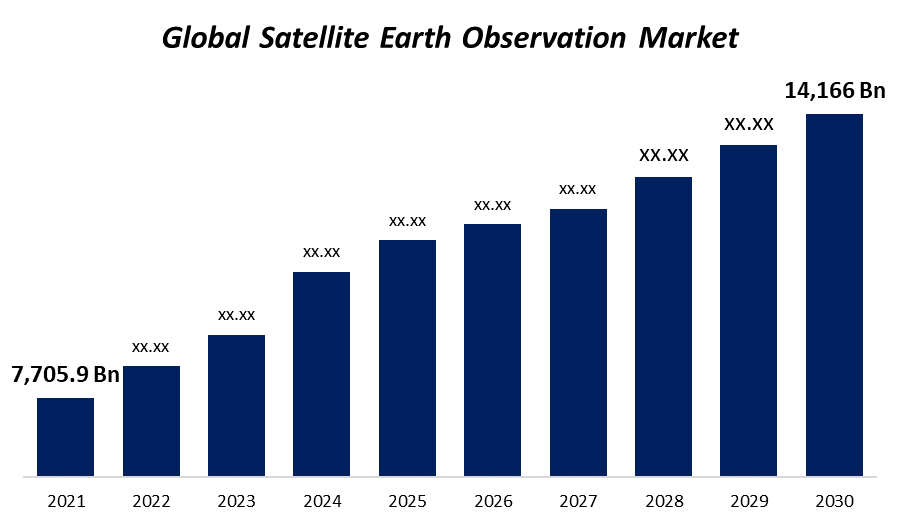Global Satellite Earth Observation Market Size To Grow USD 14166 Billion By 2030 | CAGR of 7%
Category: Aerospace & DefenseGlobal Satellite Earth Observation Market Size To Grow USD 14166 Billion By 2030
According to a research report published by Spherical Insights & Consulting, the Global Satellite Earth Observation Market Size to grow from USD 7,705.9 billion in 2021 to USD 14,166 billion by 2030, at a Compound Annual Growth Rate (CAGR) of 7% during the forecast period. The expansion of satellite earth observation is due to the increased usage of earth observation satellites in a variety of end-use industries, and the integration of digital data analysis and geospatial data fusion have all contributed to the market value increase.

Get more details on this report -
The COVID-19 pandemic has made an adverse impact on credit portfolios. There has been an unprecedented rise in unemployment and disruption in economic activity, putting a strain on the solvency of customers and companies. Central banks have taken a proactive approach by injecting liquidity into the market by lowering interest rates and asset purchase programs. Managing and monitoring credit, market, liquidity, and operational risk across financial markets were hard enough with ongoing geopolitical tensions, international trade wars, and the occasional hurricanes and earthquakes. The current pandemic situation has forced chief risk officers and their teams to recalibrate old assumptions and models used to manage and monitor risk. COVID-19’s global impact has shown that interconnectedness plays an important role in international cooperation. As a result, many governments started rushing toward identifying, evaluating, and procuring reliable solutions powered by AI.
Browse key industry insights spread across 230 pages with 195 market data tables and figures & charts from the report “Global Satellite Earth Observation Market Size, Share, and COVID-19 Impact Analysis, By Payload Type (SATCOM, EO/IR, Communication, Imaging, Navigation), By Altitude (Below 500-600 km, Above 600km), By Technology (Optical, Synthetic Aperture Radar), By Applications (Infrastructure, Environment Monitoring, Energy, Natural Resources Monitoring, Maritime, Disaster Management, Others), By End-user Vertical (Defense and Intelligence, Infrastructure and Engineering, Agriculture, Energy, and Power), and By Region (North America, Europe, Asia-Pacific, Latin America, Middle East, and Africa), Analysis and Forecast 2021 – 2030.” in detail along with the table of contents https://www.sphericalinsights.com/reports/satellite-earth-observation-market
The SATCOM segment to account for the largest market size during the forecast period
Based on the payload type, the satellite earth observation market is categorized into SATCOM, EO/IR, Communication, Imaging, and Navigation. The SATCOM segment accounts for the largest market size during the forecast period. It is anticipated that the Satcom transceiver has the greatest market. The expansion of the Satcom transceiver market has been spurred by the increasing need for transcontinental coverage across different networks. The Satcom equipment is utilized mostly for applications including the monitoring of the weather, the observation of military targets, navigation, and communications. The expansion of cloud-based services in ground mobility platforms and the growing need for high throughput satellite services are both contributing factors to the expansion of the Satcom equipment market during the course of the forthcoming forecast period.
The optical segment to hold a higher CAGR during the forecast period
Based on the technology, the satellite earth observation market is categorized into Optical and Synthetic Aperture Radar. The optical segment to hold higher CAGR during the forecast period. The optical segment will account for the greatest revenue in the market as Satellites equipped with optical technology are utilized in a variety of industries, including urban planning, agriculture, and the evaluation of damage caused by natural disasters, to name a few. Data is gathered by optical satellites with the use of sensors that can detect both visible light and near-infrared radiation. These are nadir viewing devices with a horizontal spatial resolution that can range anywhere from one to three hundred meters. It is anticipated that this will result in a significant increase in demand for optical technologies.
The disaster management segment is to hold a higher CAGR during the forecast period.
Based on application, the Satellite Earth Observation Market is categorized into Infrastructure, Environment Monitoring, Energy, Natural Resources Monitoring, Maritime, Disaster Management, and Others. The disaster management segment is to hold a higher CAGR during the forecast period. The disaster management application is anticipated to be the front runner in the global market for satellite earth observation. This is due to the ability of data and services to cater information regarding wildlife trends, land use patterns, tracking biodiversity, and managing natural resources, amongst other things; and help in attaining social, environmental, and economic sustainability.
North America is estimated to account for the highest market share in 2021.

Get more details on this report -
The Global Satellite Earth Observation market has been segmented into five major regions: Asia-Pacific, Europe, APAC, Latin America, and MEA. This is because the military and defense industries have an increasing requirement for continuous connection, which has led to a high adoption rate of satellite communication equipment by the United States Department of Defense (DoD). In addition, the expansion of the industry is taking help from a wide variety of providers of satellite communication, such as Telesat, Viasat, Inc., and EchoStar Corporation. In addition, over the course of the next few years, the regional market is expected to rapidly develop as a result of the modernization of the military's communication infrastructure. Asia-Pacific to hold a higher CAGR during the forecast period.
Major vendors in the Global Satellite Earth Observation Market include Airbus SAS, Ball Corporation, DigitalGlobe, L3Harris Technologies Inc., Lockheed Martin Corporation, OHB System AG, Thales Group, and Boeing.
Key Target Audience
- Market Players
- Investors
- End-users
- Government Authorities
- Consulting And Research Firm
- Venture capitalists
- Third-party knowledge providers
- Value-Added Resellers (VARs)
Market Segment
This study forecasts revenue at global, regional, and country levels from 2019 to 2030. Spherical Insights has segmented the global satellite earth observation market based on the below-mentioned segments:
Global Satellite Earth Observation Market, By Payload Type
- SATCOM
- EO/IR
- Communication
- Imaging
- Navigation
Global Satellite Earth Observation Market, By Altitude
- Below 500-600 km
- Above 600 km
Global Satellite Earth Observation Market, By Technology
- Optical
- Synthetic Aperture Radar
Global Satellite Earth Observation Market, By Application
- Infrastructure
- Environment Monitoring
- Energy
- Natural Resources Monitoring
- Maritime
- Disaster Management
- Others
Global Satellite Earth Observation Market, By End-user Vertical
- Defense and Intelligence
- Infrastructure and Engineering
- Agriculture
- Energy and Power
Global Satellite Earth Observation Market, Regional Analysis
- North America
- US
- Canada
- Mexico
- Europe
- Germany
- Uk
- France
- Italy
- Spain
- Russia
- Rest of Europe
- Asia Pacific
- China
- Japan
- India
- South Korea
- Australia
- Rest of Asia Pacific
- South America
- Brazil
- Argentina
- Rest of South America
- Middle East & Africa
- UAE
- Saudi Arabia
- Qatar
- South Africa
- Rest of Middle East & Africa
About the Spherical Insights & Consulting
Spherical Insights & Consulting is a market research and consulting firm which provides actionable market research study, quantitative forecasting and trends analysis provides forward-looking insight especially designed for decision makers and aids ROI.
Which is catering to different industry such as financial sectors, industrial sectors, government organizations, universities, non-profits and corporations. The company's mission is to work with businesses to achieve business objectives and maintain strategic improvements.
CONTACT US:
For More Information on Your Target Market, Please Contact Us Below:
Phone: +1 303 800 4326 (the U.S.)
Phone: +91 90289 24100 (APAC)
Email: inquiry@sphericalinsights.com, sales@sphericalinsights.com
Contact Us: https://www.sphericalinsights.com/contact-us
Follow Us: LinkedIn | Facebook | Twitter
Global Satellite Earth Observation Market Size Overview 2021 - 2030: Watch Video By YouTube
Frequently Asked Questions (FAQ)
-
What is the market size of the Satellite Earth Observation market?As per Spherical Insights, the size of the Satellite Earth Observation market was valued at USD billion 7,705.9 in 2021 to USD 14,166 billion by 2030.
-
What is the market growth rate of the Satellite Earth Observation market?The Satellite Earth Observation market is growing at a CAGR of 7% from 2021 to 2030.
-
Which country dominates the Satellite Earth Observation market?North America emerged as the largest market for Satellite Earth Observation.
-
Who are the key players in the Satellite Earth Observation market?Key players in the Satellite Earth Observation market are Airbus SAS, Ball Corporation, DigitalGlobe, L3Harris Technologies Inc., Lockheed Martin Corporation, OHB System AG, Thales Group, Boeing.
-
Which factor drives the growth of the Satellite Earth Observation market?Satellite imagery has benefited from recent advances drives the market's growth.
Need help to buy this report?